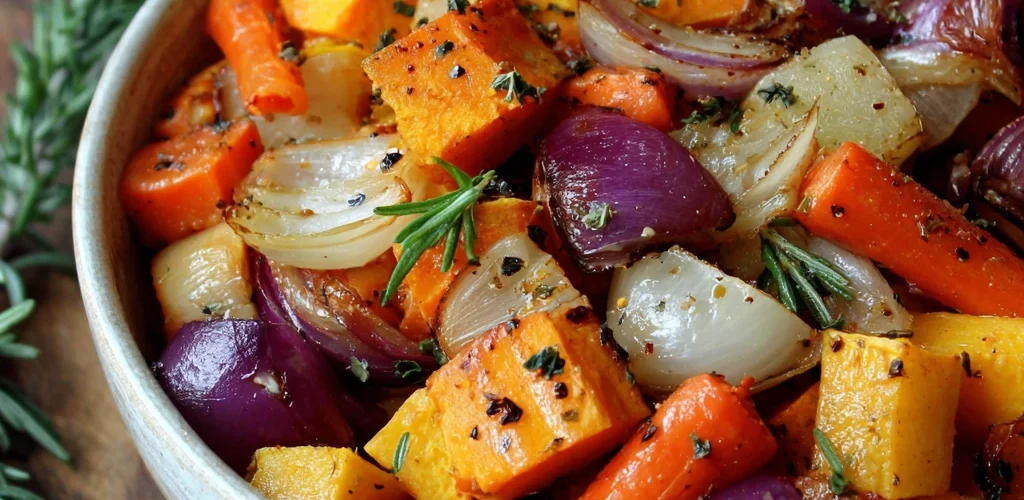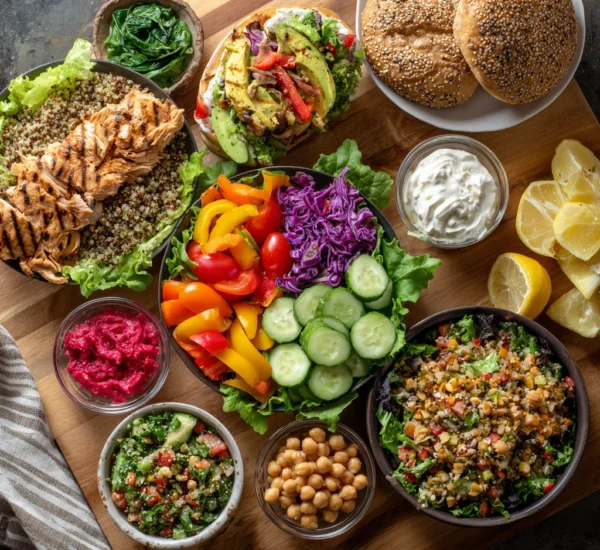The Joy of Seasonal Cooking: A Guide to Savoring Fresh Flavors Year-Round
Seasonal cooking is more than just a trend; it’s a conscious choice to embrace the natural rhythms of the earth and celebrate the unique flavors each season has to offer. By prioritizing ingredients that are at their peak, you’re not only treating yourself to the best possible taste and nutrition, but also supporting local farmers and reducing your environmental impact. This guide will explore the benefits of seasonal cooking, offer tips for getting started, and provide inspiration for enjoying the fruits (and vegetables!) of each season.

Why Embrace Seasonal Eating?
Choosing to cook seasonally offers a multitude of benefits that extend beyond just delicious meals. From enhanced flavor and nutrition to economic and environmental advantages, the reasons to embrace seasonal eating are compelling.
Flavor at Its Finest
When fruits and vegetables ripen naturally in their appropriate season, they develop a depth of flavor that is simply unmatched by produce grown out of season. Think of the burst of sweetness from a perfectly ripe summer tomato, or the earthy aroma of freshly harvested autumn squash. These flavors are intensified when the produce is allowed to mature in its natural environment, resulting in dishes that are more vibrant and satisfying.
Nutritional Powerhouse
Seasonal produce is packed with essential vitamins and minerals. When fruits and vegetables are allowed to ripen on the vine or in the field, they have more time to absorb nutrients from the soil. Furthermore, produce that is transported long distances and stored for extended periods can lose some of its nutritional value. By choosing seasonal ingredients, you’re ensuring that you’re getting the most nutritional bang for your buck.
Supporting Local Communities
Opting for seasonal ingredients often means supporting local farmers and producers. By purchasing directly from farmers’ markets, farm stands, or community-supported agriculture (CSA) programs, you’re investing in your local economy and helping to preserve farmland. This also allows you to connect with the people who grow your food and learn more about their sustainable farming practices.
Reducing Your Environmental Footprint
Shipping produce across vast distances requires significant amounts of energy and resources. By choosing seasonal, locally sourced ingredients, you can significantly reduce your carbon footprint. Seasonal eating also encourages the consumption of produce that requires less pesticides and herbicides, as they are naturally more resistant to pests and diseases when grown in their optimal environment.
Getting Started with Seasonal Cooking
Embarking on a journey of seasonal cooking can seem daunting at first, but with a few simple tips, it can become an enjoyable and rewarding experience.
Know Your Seasons
The first step is to familiarize yourself with what produce is in season in your region. Resources like local farmers’ markets, online seasonal food guides, and agricultural extensions can provide valuable information. Understanding the seasonality of different fruits and vegetables will allow you to plan your meals accordingly and take advantage of the freshest ingredients available.
Visit Your Local Farmers' Market
Farmers’ markets are a treasure trove of seasonal produce. Not only will you find a wide variety of fresh, locally grown ingredients, but you’ll also have the opportunity to speak directly with the farmers who grew them. This provides a valuable opportunity to learn about their growing practices, get cooking tips, and discover new and exciting varieties of produce.
Join a CSA Program
Community Supported Agriculture (CSA) programs offer a direct connection between consumers and farmers. By subscribing to a CSA program, you receive a weekly or bi-weekly share of the farm’s harvest throughout the growing season. This is a great way to discover new fruits and vegetables, support local agriculture, and ensure that you always have a supply of fresh, seasonal ingredients on hand.
Embrace Flexibility in the Kitchen
Seasonal cooking requires a degree of flexibility in the kitchen. Be prepared to adapt your recipes based on what’s available at the market or in your garden. This encourages creativity and experimentation, leading to new and exciting culinary discoveries. Don’t be afraid to try new recipes or adapt existing ones to incorporate seasonal ingredients.
Preserving the Harvest
When seasonal produce is abundant, consider preserving some of the harvest for later use. Canning, freezing, drying, and pickling are all great ways to extend the shelf life of seasonal fruits and vegetables and enjoy their flavors throughout the year.
Seasonal Inspiration: A Culinary Journey Through the Year
Each season brings its own unique bounty of flavors. Here’s a glimpse into the culinary delights that each season has to offer:
Spring: A Time of Renewal
Spring is a time of renewal and rebirth, reflected in the fresh, vibrant flavors of the season. Asparagus, peas, spinach, radishes, and rhubarb are just a few of the ingredients that come into their own in the spring.
- Asparagus: Grill it, roast it, or steam it and serve it with a squeeze of lemon juice or a sprinkle of Parmesan cheese.
- Peas: Enjoy them fresh in salads, sauté them with butter and mint, or use them to make a creamy pea soup.
- Spinach: Add it to salads, smoothies, or stir-fries. It can also be used to make a delicious spinach and ricotta pie.
- Radishes: Slice them thinly and add them to salads or sandwiches for a peppery crunch.
- Rhubarb: Use it to make pies, crumbles, or jams. Its tart flavor pairs well with strawberries and ginger.
Summer: A Burst of Sunshine
Summer is a time for juicy fruits and vibrant vegetables. Tomatoes, corn, zucchini, berries, and peaches are just a few of the ingredients that shine in the summer.
- Tomatoes: Enjoy them fresh in salads, sandwiches, or sauces. Roast them for a deeper, more concentrated flavor.
- Corn: Grill it, boil it, or roast it and serve it with butter and salt.
- Zucchini: Grate it into breads and muffins, sauté it with garlic and herbs, or grill it and serve it as a side dish.
- Berries: Enjoy them fresh in smoothies, salads, or desserts. Use them to make jams, preserves, or pies.
- Peaches: Grill them, bake them into pies, or enjoy them fresh with yogurt or granola.
Autumn: Earthy Delights
Autumn brings a bounty of earthy flavors and hearty vegetables. Squash, pumpkins, apples, pears, and root vegetables are just a few of the ingredients that are at their peak in the fall.
- Squash: Roast it, purée it into soups, or use it to make pies and breads.
- Pumpkins: Roast the seeds for a healthy snack, or purée the flesh for soups, pies, and breads.
- Apples: Enjoy them fresh, bake them into pies and crisps, or make applesauce.
- Pears: Enjoy them fresh, bake them into pies and tarts, or poach them in wine.
- Root Vegetables: Roast them, mash them, or add them to soups and stews.
Winter: Comfort and Warmth
Winter is a time for hearty meals and comforting flavors. Citrus fruits, kale, Brussels sprouts, sweet potatoes, and winter squash are just a few of the ingredients that can brighten up the winter months.
- Citrus Fruits: Enjoy them fresh, squeeze them into juices, or use them to make marmalades.
- Kale: Sauté it with garlic and olive oil, add it to soups and stews, or bake it into kale chips.
- Brussels Sprouts: Roast them with bacon and balsamic vinegar, or shred them and add them to salads.
- Sweet Potatoes: Roast them, mash them, or use them to make sweet potato pie.
- Winter Squash: Roast it, purée it into soups, or use it to make pies and breads.
Elevating Your Seasonal Cooking Skills
While embracing seasonal ingredients is a fantastic first step, mastering some basic techniques can elevate your seasonal cooking to a whole new level.
Mastering Basic Cooking Techniques
Understanding fundamental cooking methods like sautéing, roasting, grilling, and braising allows you to highlight the unique characteristics of each seasonal ingredient. Knowing how to properly caramelize onions, roast vegetables to perfection, or create a flavorful broth can transform simple seasonal ingredients into culinary masterpieces.
Herb and Spice Pairing
Experimenting with different herbs and spices can enhance the flavors of seasonal produce. Fresh herbs like basil, thyme, rosemary, and mint can add brightness and complexity to dishes, while spices like cinnamon, nutmeg, ginger, and cloves can bring warmth and depth to autumnal and winter meals.
Understanding Flavor Profiles
Learning about flavor profiles and how different ingredients interact with each other can help you create balanced and harmonious dishes. For example, pairing sweet ingredients with acidic ingredients can create a delightful contrast, while combining earthy ingredients with aromatic herbs can create a more complex and nuanced flavor.
Presentation Matters
The way you present your food can have a significant impact on the overall dining experience. Take the time to arrange your dishes artfully and consider adding garnishes that complement the flavors of the ingredients. A simple sprig of parsley, a drizzle of olive oil, or a sprinkle of toasted nuts can elevate a dish from ordinary to extraordinary.
Continuous Learning and Experimentation
The journey of seasonal cooking is an ongoing process of learning and experimentation. Don’t be afraid to try new recipes, explore different flavor combinations, and adapt your cooking techniques to suit your personal preferences. The more you cook with seasonal ingredients, the more you’ll develop your own unique style and create dishes that are both delicious and satisfying.
Frequently Asked Questions About Seasonal Cooking
Here are some commonly asked questions about seasonal cooking:
What does it mean to cook seasonally?
Cooking seasonally means using fruits and vegetables that are naturally ripe and available in your local area during a specific time of year.
How do I know what produce is in season?
Check your local farmers’ markets, online seasonal food guides, or consult with your local agricultural extension office.
Is seasonal cooking more expensive?
Not necessarily. While some seasonal produce may be more expensive than out-of-season options, you can often find great deals at farmers’ markets and through CSA programs.
What are the benefits of eating seasonally?
Eating seasonally offers a multitude of benefits, including enhanced flavor and nutrition, support for local farmers, and a reduced environmental impact.
What if I can't find seasonal ingredients?
Look for frozen or canned fruits and vegetables, which can be a good alternative when fresh seasonal produce is not available. You can also try growing your own fruits and vegetables in a garden or container garden.




